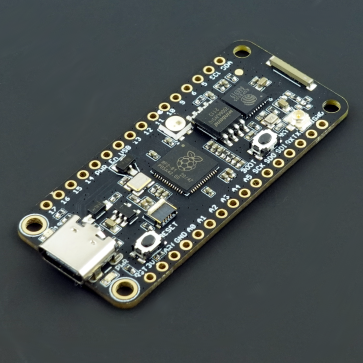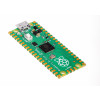Challenger NB RP2040 WiFi with U.FL. connector
Delivery Time: ab Lager
Verfügbarkeit: Sofort-Versand ab Lager
The Challenger RP2040 WiFi is an Arduino/Micropython compatible Challenger NB format micro controller board based on the Raspberry Pico chip. The Challenger NB form factor is largely based on the Feather format developed by Adafruit but we have removed the battery connector and the charging circuit and added some well needed extra IO pins.
When we designed this board we took our existing Challenger RP2040 WiFi board and simply applied the new form factor, keeping most of the good stuff on board such as the powerfull RP2040 micro controller from the Raspberry Pi foundation as well as the WiFi chip and antenna.
WiFi
Just like the Challenger RP2040 WiFi it has a ESP8285 WiFi chip. For those of you that is unfamiliar with this device, it is basically an ESP8266 device with an integrated 1MByte of flash memory. This allows us to have an AT command interpreter inside this chip that the main controller can talk to and connect to you local WiFi network. The communications channel between the two devices is an unused UART on the main controller and the standard UART on the ESP8285. As simple as it can be.
The ESP8285 chip comes pre-flashed with Espressif’s AT command interpreter stored in the internal 1MByte of the ESP8285. This interpreter support most of the operating and sleep modes of the standard ESP8266 framework which makes it easy to work with. Talking to the device is as easy as opening the second serial port (Serial2), resetting the ESP8285 and start listening for events and sending commands
I2C Flexibility
On this board we are also introducing our own take on the popular Groove format from Seeed Technologies. We wanted to make it easier to build highly integrated stuff using our boards and cables normally take up a lot of room and are messy to deal with. And with the experience from another project we decided to used a FPC connector that will allow you to use a flex cable that is only 2.5mm wide and 0.13mm thick. The cable can be bent and shaped to fit you enclosure exactly and the taped into place taking up in practice no place at all.
USB Type C
In the recent years we have noticed that we are seeing more and more USB Type C cable laying around the lab due to the fact that all new phones and accessories use them. As of yet we haven’t seen any shortage of micro USB cables but we are not getting any new ones any more and old ones do break occasionally. So we decided to go for a USB Type C connector for this board. A bonus of this is that they are quite bit more durable and you don’t have to fiddle with the cable before plugging it in.
has a U.FL connector on board which requires you to add an external antenna for your system. You can basically use any 50ohm 2.45GHz antenna and it will work just fine.








